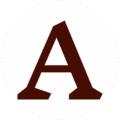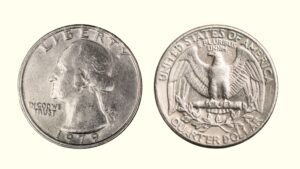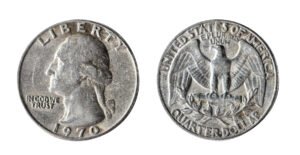An old 1983 Washington quarter might look like an ordinary clad coin from the ’80s at the first glance. But did you know that this coin once sold for a mind-boggling price of over $15,800 in an auction? Well, your quarter dollar might be worth a fortune, too! Learn which factors and features impact its worth in the coin collecting world!
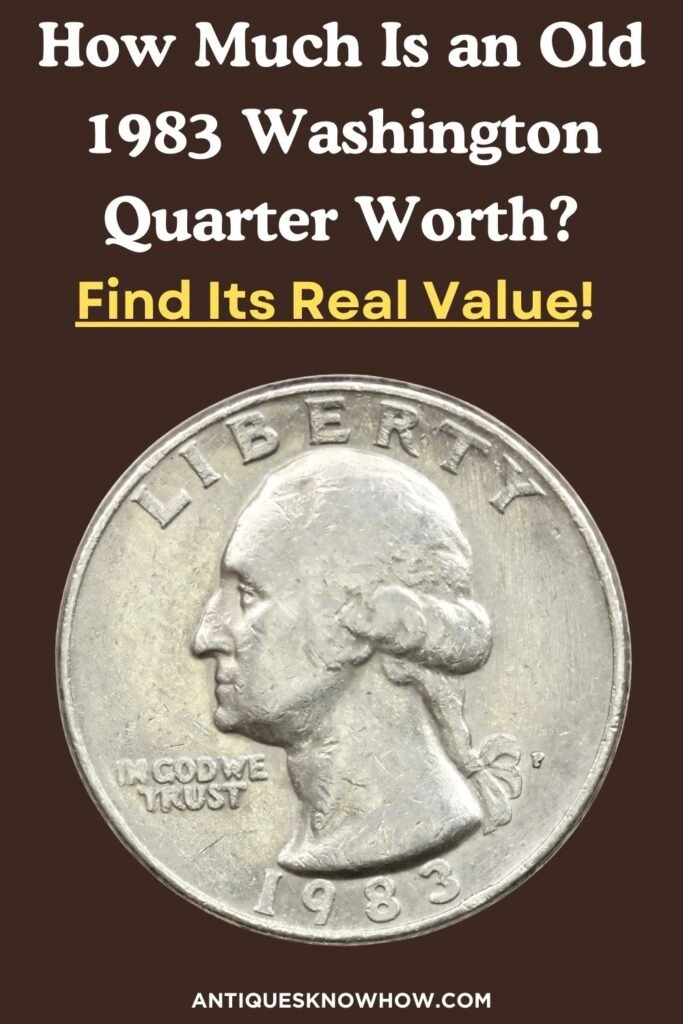
A circulated 1983 Washington quarter is worth its face today, which is $0.25, However, this value can reach as high as a few thousand dollars, for well-preserved coins in excellent condition or those with rare errors!
Interesting History of 1983 Washington Quarter Dollar
The Washington Quarter made its debut in 1932, celebrating the 200th anniversary of George Washington’s birth. By 1983, it had become a familiar coin in American currency. This year saw the significant production of the clad quarters, which had been there in the run since 1965 after the US Mint changed composition from silver to copper nickel clad.
The coins were struck at the three main facilities: Philadelphia, Denver, and San Francisco, leading to an overall mintage surpassing 1.2 billion coins.
| 1983 Washington Quarter | Key Facts |
| Coin Composition | copper-nickel-clad |
| Minting Location | Philadelphia, Denver, San Francisco |
| Year of Minting | 1983 |
| Weight | 5.67 g |
| Diameter | 24.26 mm |
| Thickness | 1.75 mm |
| Designer | John Flanagan |
| Face Value | $0.25 (25 cents) |
| Mint Marks | D – Denver Mint S – San Francisco P – Philadelphia |
| Total Mintage | 1,294,620,572 |
Understanding a 1983 Quarter Design & Composition
To rightly assess an old 1983 Washington quarter dollar value, you must understand its unique design, composition, dimensions, and other physical features.
1983 Washington Quarter Obverse:

- A left-facing profile of George Washington
- “IN GOD WE TRUST” written to the left of Washington’s bust
- The mint date “1983” at the bottom
- The word “LIBERTY” above Washington’s head
- “D” or “S” mint mark, if present, near Washington’s ponytail
1983 Washington Quarter Reverse:

- A left-facing eagle with large, spread-out wings
- A bundle of arrows in eagle’s claws
- Two olive branches tied together below the eagle
- The US motto, “E. PLURIBUS UNUM,” above the eagle’s head
- “UNITED STATES OF AMERICA” along the upper half-edge
- The denomination “QUARTER DOLLAR” on the bottom
Coin Composition, Size & Physical Features
The 1983 Washington quarter is made of a unique clad composition featuring 75% copper and 25% nickel over a pure copper center, giving it a silvery look. This composition also contributes to the quarter’s distinctive weight of 5.67 grams.
The coin has a diameter of 24.26 mm and a thickness of 1.95 mm, with a well-reeded edge with uniform grooves. By verifying all these details, you can easily ensure whether an old 1983 quarter is real or counterfeit.
Finding a 1983 Quarter Value (4 Key Factors)
| Coin Grades | Condition Details | 1983 P Mark Quarter Value | 1983 D Quarter Value |
| Poor (0) to Extremely Fine (XF45) | Significant wear, faded but visible details | 25 to 40 cents | 25 to 40 cents |
| Almost Uncirculated (AU50) to Mint State (AU58+) | Slight wear on highest points, visible marks or blemishes | 50 cents to 80 cents | 50 cents to $1 |
| Mint State (MS60 – MS64) | Uncirculated with minimal wear | $2 – $10 | $5 – $12 |
| Mint State (MS65 – MS66+) | Nearly flawless with very minor imperfections | $10 – $230+ | $12 – $250+ |
| Mint State (MS67 – MS67+) | Well-preserved with no major flaws | $280 – $2,600+ | $320 – $1,500+ |
| Mint State (MS68 or Above) | Nearly perfect, luster, no major marks or flaws | N/A | N/A |
1. Coin Condition and Grades
The condition of your 1983 quarter dollar is the first and most important factor influencing its value. Generally, coins’ condition is graded on a scale ranging from Poor (P-1) to Mint State (MS-70), with high grades indicating a well-preserved coin without any significant wear.
Pay attention to features such as luster, scratches, and details of your 1983 clad quarter, as they determine grades, which impact the value.
The 1983 quarter in high mint grade can fetch significantly higher values than one in a circulated or low grade. For example, an MS67 1983 p Washington Quarter coin sold for almost $2,540 at Great Collections, while the same coin in MS65 grade is only worth $10 to $50.
2. 1983 Quarter Mint Marks & Mintage
The mintage of a 1983 Washington quarter directly impacts its rarity and, hence, its value. Quarter produced with certain mint marks can be more valuable than others.
1983 P Washington Quarter (Mintage – 673,535,000)
The Philadelphia Mint, which produced the most 1983 P Quarter coins, added a P mint mark to the coin. 1983 P quarter coins are worth face value in circulated condition. Uncirculated coins can fetch $2 to $30, with MS66 grades reaching $40 to $230, and MS67 examples reaching as much as $280 to $2,500 at auction!
The highest price released for an MS67 1983 P mint mark 25C coin is $2,596 at Heritage Auctions.
1983 D Washington Quarter (Mintage – 617,806,446)
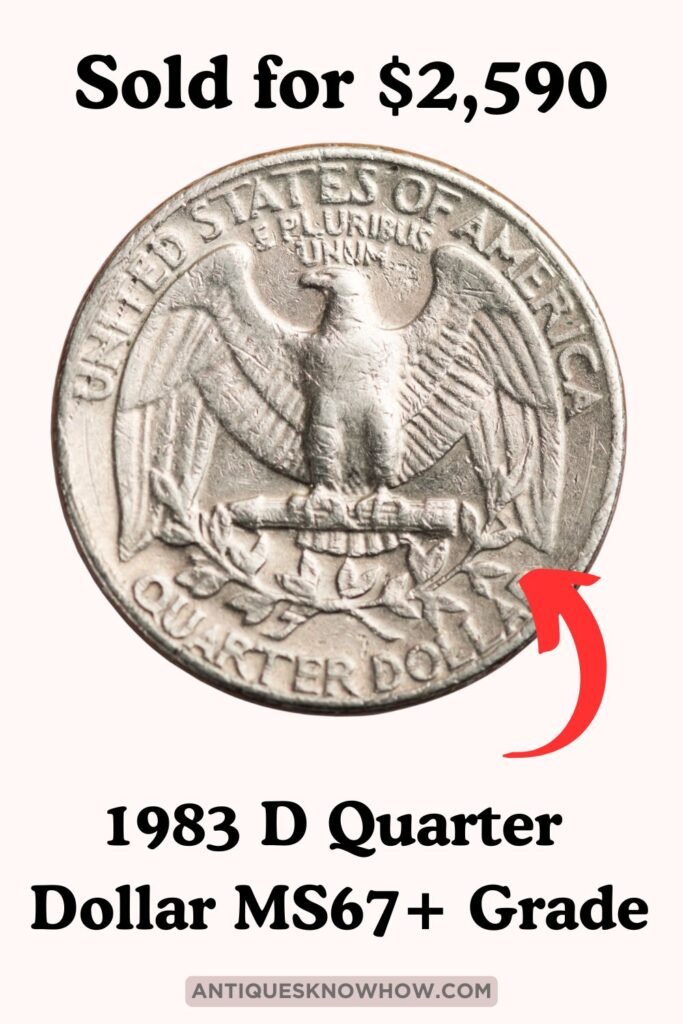
The Denver Mint produced slightly lesser 1983 quarter dollars, identified by the “D” mint mark, compared to the Philadelphia Mint. The value of 1983 D quarter ranges in average condition is around its face value.
However, higher grades like MS66 can command around $60 to $110, with MS67-grade 1983 D quarters reaching values between $320 and $1,350.
3. 1983 S Proof Quarter Coin (Mintage – 3,279,126)
The San Francisco Mint struck over 3.2 million proof quarter coins especially for coin collectors. These coins bear an S mint mark on the obverse and feature a highly detailed, reflective proof surface on both sides.
The majority of these proof 1983 quarter coins exhibit regular proof finish, worth a few dollars. However, some proof coins exhibit a strong contrast between the frosted raised designs and reflective fields, known as Cameo or Deem Cameo.
Cameo 1983 S Washington quarter proofs are relatively inexpensive compared to regular proof coins, with the highest grade, PR70, examples reaching up to $500.
4. 1983 Quarter Dollar Mint Errors
Minting errors make common coins more exciting for collectors, who are willing to pay hefty prices. For a 1983 Washington Quarter, the following errors are most collectible:
Spitting Eagle (Die Crack Error)

This one is a die crack error (caused by a crack in the die) that appears as a line extending from the eagle’s beak on the reverse, making it look like the eagle’s spitting. To spot it, look for a raised line in front of the eagle’s mouth.
The value can range from $50 to $400, depending on the prominence of the “spit” and the coin’s condition. For example, an MS65 example of a 1983 quarter with Spitting Eagle error sold for $435 on eBay and an MS66 example sold for over $350.
Overstruck on an Amusement Token
This rare error happens when a 1983 Washington Quarter is struck on a pre-existing amusement token instead of an intended planchet. This rare coin has a brassy color with a greenish patina instead of silvery color.
Its obverse shows faded “THIS IS MY LUCKY DAY” text, and the reverse shows “FOR PLAY ONLY, NO CASH VALUE.” This rare coin, graded MS65 by PCGS, sold for an extraordinary price of $15,862 at Heritage Auctions in 2014!
Finned Rim, Reverse Indent
This rare variety combines two mint errors: a finned rim which occurs from metal flow issues during striking causing a thin, raised line along the coin’s edge, and the reverse indent caused by another planchet getting in the die. An MS63-grade example of this error quarter sold for about $310 in a coin auction!
Off-center Strike Error
An off-center strike occurs when the planchet is misaligned in the die, causing a part of the design to be missing, leaving a blank area on one side of the coin. The value of an off-center 1983 quarter dollar ranges from $20 to $100, depending on the off-center percentage and the coin’s condition.
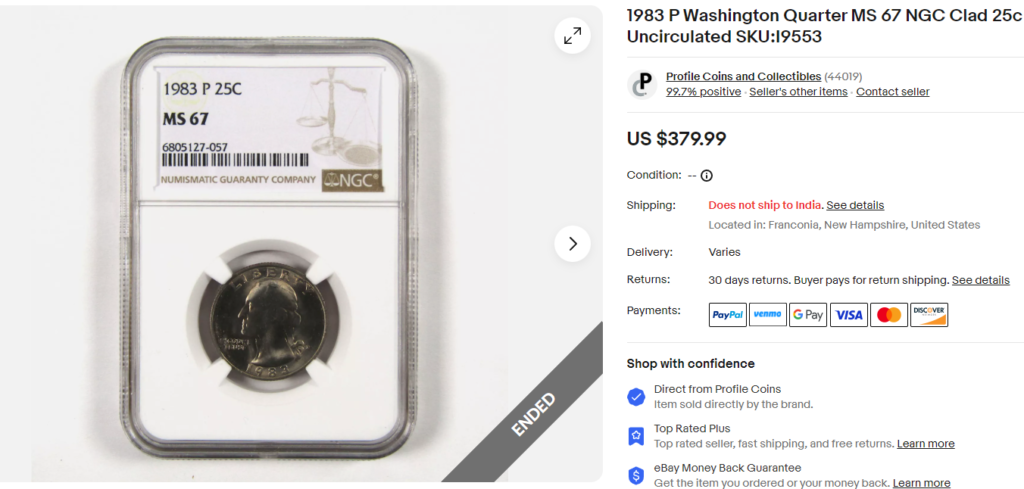
Struck on 5C Nickel Planchet
When a 1979 quarter design is struck on a nickel planchet, it results in a rare quarter coin with a weight of 5g instead of 5.67g and a smaller diameter. Besides, the coin features a different color and feel. An MS64-grade 1983 25C Struck on a Nickel collected $258 in an auction!
Such rare minting errors as well as other factors listed in this value can seriously impact a 1983 quarter value, hiking it from a few cents to thousands!
Note: This article is intended for informational, educational, and entertainment purposes only. Some images are illustrative and may not represent actual brands, products, or related entities. All trademarks, product names, brand logos, packaging, and other intellectual property referenced remain the exclusive property of their respective owners. Any brand mentions or references are provided solely for descriptive and educational context and do not imply any formal or commercial association.

